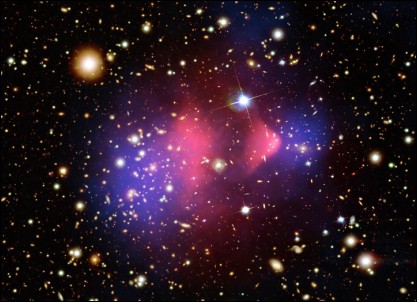The Bullet Cluster — a spectacular collision between two clusters of galaxies — is often cited as the best evidence to date for the existence of dark matter. But according to John Moffat at the University of Waterloo and Joel Brownstein at the Perimeter Institute for Theoretical Physics in Ontario, Canada, the nature of the collision can be explained using normal matter only — that is, if you’re willing to accept their theory of modified gravity, or “MOG” (Mon. Not. R. Astron. Soc. online early article).

Lying over three billion light years away, the Bullet Cluster consists of a small subcluster ploughing through the centre of a larger one at speeds of six million miles per hour. During such a collision the stars pass each other by with little effect while the intervening hot gas is slowed down.
To see how mass is distributed in the Bullet Cluster, scientists examine how it behaves as a “gravitational lens” by bending the path of passing light. In 2006, astrophysicists noted that X-ray light emitted from very distant galaxies travelling through the Bullet Cluster to Earth was bent more by the small galaxies at the sides rather than the hot gas dominating the centre, which represents most of the normal matter. This implied that there is an extra mass component that is not associated with normal matter, leading many physicists to hail it as strong evidence for dark matter. Assuming conventional theories of gravity are true, dark matter is predicted to comprise about 95% of all gravitating mass in the universe.
Moffat and Brownstein, however, argue MOG can provide a more natural explanation by removing the need to invoke mysterious dark matter. Essentially MOG adds extra terms to Einstein’s theory of gravitation — general relativity — that allow the gravitational constant G to vary across space and time. The researchers modelled the hot gas distribution using their MOG theory, and found the gravitational force would be stronger as you move away from the centre of the Bullet Cluster, explaining the stronger lensing seen at the edges.
“Whenever dark matter is said to dominate a system, in MOG, the extra gravity exerts a strong and measurable influence based only on the observable [normal] matter,” explained Brownstein. The researchers have used MOG before to explain the dynamics of hundreds of galaxies and clusters. They also argue MOG could account for the apparent anomalous deceleration of the Pioneer space probes launched in the early 1970s, and even for dark energy — the strange energy responsible for the accelerated expansion of the universe.
Others are more sceptical. “I most definitely do not agree with their conclusions,” Doug Clowe at Ohio University, one of the researchers who took the original gravitational-lensing data from the Bullet Cluster, told physicsworld.com. “Their lensing reconstruction of the gas mass does not fit the lensing reconstruction of the cluster. Their claim is that the difference can be explained by the lensing from the cluster galaxies, but nowhere in the paper do they demonstrate this.”



